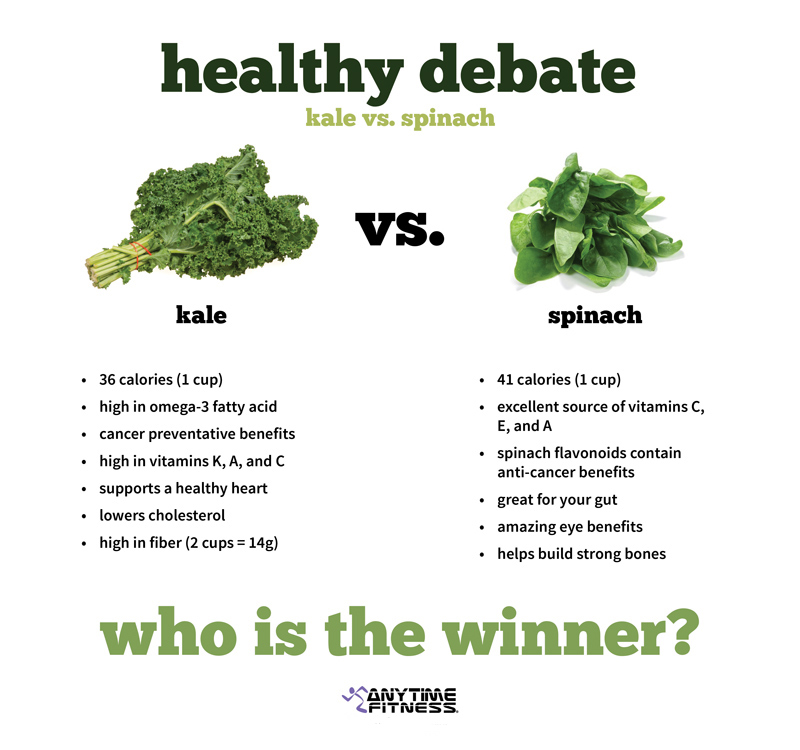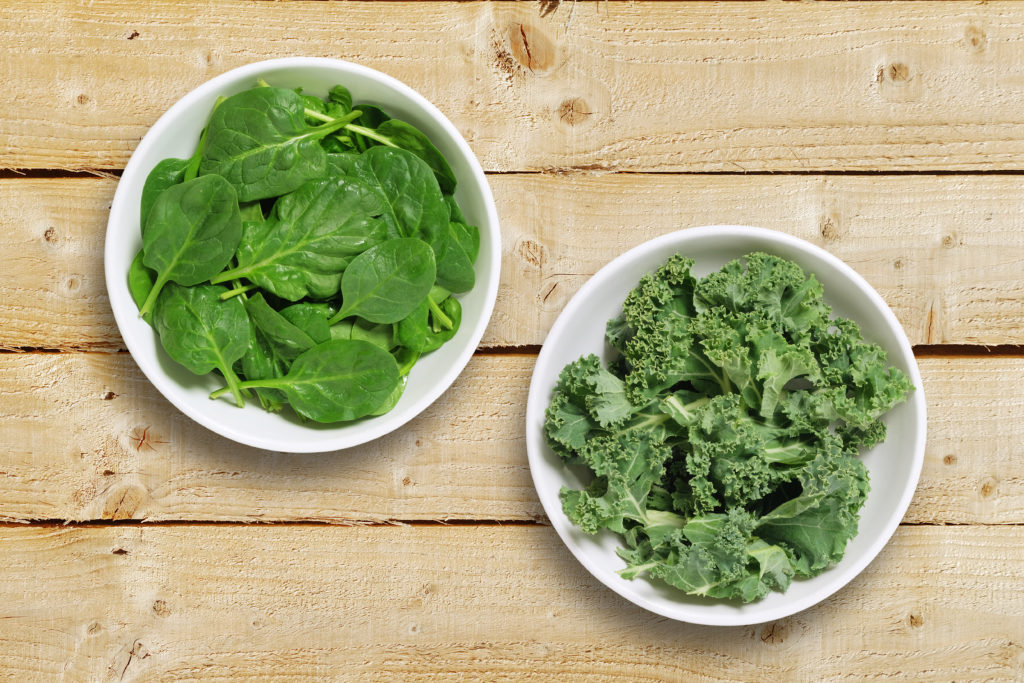Spinach wilted the day kale was announced as a “superfood.” Well, not exactly. But it seems that everyone forgot about this valuable green under the kale craze spell. Rightfully so. They didn’t name kale a superfood for nothing.
While kale is one leaf short of having superpowers – and we encourage you to eat it by the handful – there are some definite pluses and minuses to BOTH of these veggies that we must consider when selecting the perfect leafy green. Let’s compare a few.
Kale vs. Spinach: The Great Green Debate
To keep things fair, let’s compare one cup of spinach to one cup of kale. Both of these green leafy vegetables have lots of health benefits, contain tons of Vitamin C, and make great salads and side dishes.
Are you familiar with the term “cruciferous vegetables?” Cruciferous vegetables comprise a diverse group of veggies, ranging from broccoli to Brussels sprouts to bok choy. This group of veggies is known for being rich in fiber, low in calories, and chock-full of vitamins and minerals that may help to lower inflammation and reduce the risk of developing cancer. While this group of vegetables comes in lots of different shapes and sizes, if you’re eating something green and crunchy, it’s probably cruciferous. So kale, but not spinach (which is more leafy) falls into the category of cruciferous vegetables. However, that’s no reason to jump off the spinach train – spinach contains many of these healthy benefits as well, it’s just classified differently.
We can’t be clear enough that both spinach and kale have great health benefits and deserve a place in your diet. However, each of the veggies has a certain nutritional profile that might make it a better fit for your health needs, which is why it can be helpful to know the difference between these two nutritional powerhouses. Let’s break it down by a few key categories.
Calories
One cup of raw kale has 36 calories, while one cup of raw spinach has 41 calories. So, spinach and kale are basically equivalent in terms of calorie content. Plus, they both get major bonus points for packing such a high nutritional value into so few calories!
Omega-3s
Kale is higher in omega-3 fatty acids than spinach. People who eat diets high in Omega-3s can improve their brain health and reduce blood clots, so if either of those is one of your health goals, we’d recommend adding kale to your diet, stat!
Vitamins
Have you ever been told to “eat the rainbow?” Well, that’s because foods with the most color often have the most vitamin and mineral content! Both of these beautiful leafy greens contains more than their fair share of vitamins, but despite their similarity in color, their vitamin content does vary. Both raw kale and spinach have high concentrations of Vitamin C and Vitamin A. Spinach, however, has more Vitamin E, while kale has more Vitamin K. Easy to remember, right?
Vitamin E is great for your immune system and eyesight, while Vitamin K is a key player in preventing blood clots. Again, kale is a great choice for people with a higher risk of blood clots, and Vitamin E is a great addition to any healthy diet. When it comes to vitamins, you really can’t go wrong.
Calcium
Calcium promotes bone health, muscle health and heart health, which makes it one of the most important minerals in our diets. It also plays a key role in preventing kidney stones. Both spinach and kale are high in calcium content, but kale has slightly more, so for people looking to incorporate more calcium in your diet, kale is the best choice!
Fiber
Spinach and kale both have great fiber content (although kale does contain slightly more). Researchers have proved the importance of fiber in our diets time and time again. Research has shown that people who eat the most fiber-rich foods have the lowest risk of dying and/or developing chronic disease, when compared to people who eat fewer fiber-rich foods. So get your fiber in – it’s just a fact!

Who’s the Winner?
It’s obvious that kale deserves the “superfood” title when it comes to its vitamin and mineral profile. However, spinach is a folate green goldmine, with three times more folate than kale. Here’s an important fact for pregnant women: folate helps prevent neural tube defects. So, people who are expecting might want to lean towards spinach for a while. But at the end of the day, both of these veggies is a great source of vitamins and minerals, and a great choice for any diet.
Ways to Eat Spinach and Kale
Here’s a common struggle that people encounter when trying to make healthy changes to their diet: We know that certain foods are good for us, but we might not know how to eat them! Now that you know all the awesome health benefits of spinach and kale, you might be wondering what the best way is to incorporate these leafy greens into your diet. Don’t worry, we’re not going to ask you to eat them handful after handful (although there’s nothing wrong with that). We recommend using these greens as the base of a yummy salad, scrambling them in with eggs, or blending them into a fruit smoothie – you’ll be amazed at how the taste disappears, particularly for spinach!
We would also be remiss to write an article about the benefits of kale without telling you about kale chips. Kale chips are so delicious, you won’t even know you’re eating a vegetable! To make kale chips, preheat your oven to 350 degrees. Remove the kale leaves from the stems and arrange them on a baking sheet. Then, drizzle the sheet with olive oil, and rub the olive oil into the leaves. Once the leaves are covered, sprinkle them with salt. You can also add your favorite seasoning, or mix and match spices once you’ve made them a few times. Once the leaves are prepped, bake the kale chips for 10-15 minutes. Watch them carefully to make sure they don’t burn, then cool and enjoy! Kale chips are a great side dish, or snack enjoyed on their own.
We prefer kale chips to spinach chips, as the texture holds up better, but you can definitely adapt this recipe to work for spinach, too! We hope you learned more about the differences between kale and spinach, and that you’ll be inspired to add more of these powerhouse veggies to your diet.



